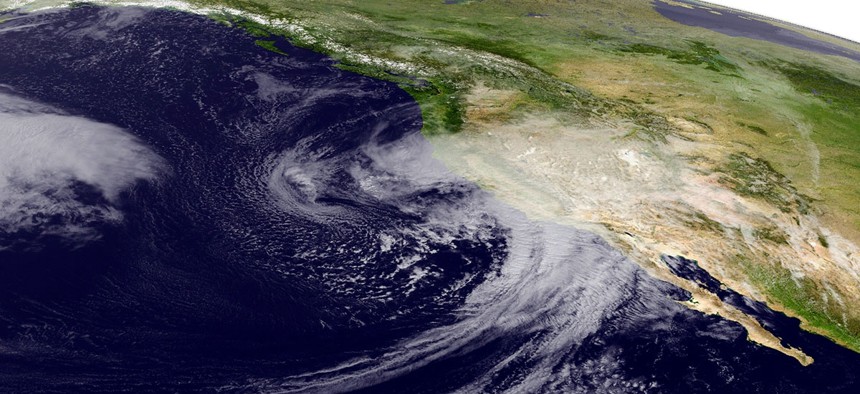Why NOAA's New Chief Data Officer Isn't Fazed by Potential Budget Cuts

This Feb. 17, 2017 satellite image released by NOAA shows a powerful storm beginning to move into California. NOAA/AP
Ed Kearns will oversee data-related projects at the Commerce agency.
The Commerce Department agency that provides weather and climate forecasts has a new chief data officer.
Ed Kearns, whose résumé includes leading the weather and science research unit and the remote sensing and application division within the National Atmospheric and Oceanic Administration, will now oversee that agency’s data programs.
NOAA could soon see budget cuts, according to President Donald Trump’s budget blueprint published last week. In one instance, the plan “zeroes out” $250 million in NOAA grants that would support marine management research. Faced with potentially restricted funding, Kearns told Nextgov one of his priorities is to work more closely with the private sector to provide the data sets entrepreneurs and technologists would find useful.
» Get the best federal technology news and ideas delivered right to your inbox. Sign up here.
"NOAA has a very strong data culture," he said. "I don’t have to do any advocacy within the organization to get people to understand the value of their data."
Instead, he plans to focus on working with other federal agencies and the private sector on making sure NOAA data is useful, he explained. Today, he said, "it’s not really an active collaboration. It’s been more of a loading-dock mentality" in which NOAA simply uploads data for others to use.
"We’re trying to change to … more of a collaboration where we understand that industry can do things with the data, [and] what we can do in terms of dissemination, analytics, artificial intelligence," Kearns added.
In addition to pushing out more climate data, Kearns plans to promote the National Water Model, newer weather analyses, and genomics data related to fish populations, among others.
Asked how the agency is preparing for potential funding cuts, Kearns said it's still unclear what the budget will actually look like. "We understand Congress has oversight of their budget [and] we’ll let those guys figure it out," he said. "I view this as a nonpartisan issue. We’re never going to have the appropriated dollars to do everything we could possibly do with the data and therefore we need to seek out these new ways of doing business."
One way to offset those cuts is to work more with the private sector.
"It’s only natural that some of our partnerships [with industry] will grow," he said, noting the agency is about two years into a big data project that includes research agreements with Microsoft, IBM, Google and other groups. "The general premise going into this partnership is first we’re targeting public dissemination: making the data available so that research will be stimulated."


